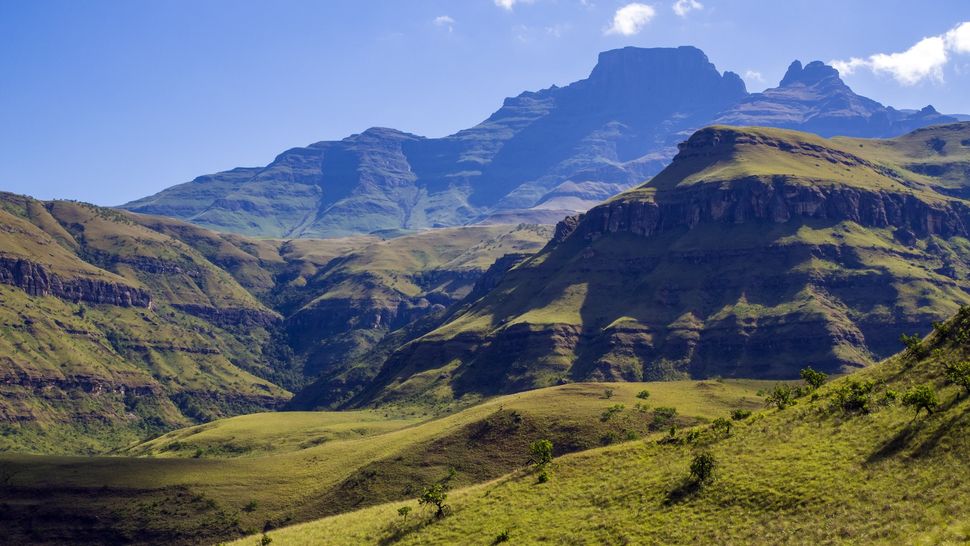Science
Related: About this forumGargantuan waves in Earth's mantle may make continents rise, new study finds
By Tia Ghose
published August 7, 2024
Dramatic cliffs and high plateaus are caused by the same wave triggered in Earth's middle layer when continents pull apart, a new study finds.

Monks Cowl in the Great Escarpment of South Africa. This dramatic formation arose during the breakup of Gondwana, a new study shows. (Image credit: Leisa Tyler via Getty Images)
High plateaus rise in the interior of continents thanks to churning deep inside Earth hundreds of miles from where they eventually spring up, new research suggests.
As continents break up, massive cliff walls may rise near the boundaries where the crust is pulling apart. That breakup sets off a wave in Earth's middle layer, the mantle, that slowly rolls inward over tens of millions of years, fueling the rise of plateaus, the new study found.
Scientists have long known that continental rifts triggered the rise of massive escarpments, like the cliff walls that separate the East African Rift Valley from the Ethiopian plateau, said lead author Thomas Gernon, a geoscientist at the University of Southampton in the U.K. And these steep cliffs sometimes fringe inland plateaus that rise from the strong, stable cores of continents, known as cratons.
. . .
In the new study, published Aug. 7 in the journal Nature, Gernon and colleagues studied three iconic coastal escarpments that formed during the breakup of Earth's last supercontinent, Gondwana. One, along India's coast, fringes the Western Ghats for about 1,200 miles (2,000 kilometers); another, in Brazil, rings the Highland plateau for about 1,900 miles (3,000 km); and the Great Escarpment of South Africa encircles the Central Plateau and spans a staggering 3,700 miles (6,000 km), according to the study. The interior plateaus in these regions can rise a kilometer or more, Gernon said.
More:
https://www.livescience.com/planet-earth/geology/scientists-finally-understand-how-the-hearts-of-continents-rise
Permanut
(7,162 posts)lastlib
(26,114 posts)I had to write a paper for an English class in college, and I chose this subject In it, I described continents as giant corks floating on magma, with their collisions resulting in mountain ranges like the Rockies, Andes, and Himalayas. This fairly confirms it.
Thanks for posting, Judi! You always come up with cool stuff! ![]() Makes DU even more interesting!
Makes DU even more interesting!
Metaphorical
(2,436 posts)The Central United States, from about Iowa all the way to Colorado, is notable for being a very long plate that rises East to West, to the extent that Denver while sitting in what appears to be a flat plane, is still 5000 ft above sea level, before starting into the foothills of the Rockies. If you think about this, it's actually pretty odd.
My theory is that this escarpment was once a relatively flat and level stretch of land. When the Pacific was forming, there was a trough (long since eroded) that created new material outward The eventually forced the subduction areas around the then North American West Coast to push up, in essence creating a chain of volcanoes that eventually surfaced, even as the increased subduction pushed up the plate itself. These proto-continent island chains in turn were pushed into the West Coast, creating tall mountains as these long island chains essentially crumped against the coast, blocking the subduction regions and forcing new subduction to occur West of the new west coast.
This is why there are clearly defined valleys both within the Rockies, and more recently, between the Rockies and the Cascades, which are still being formed. The Olympic mountains (and the Olympic Peninsula) may be the remnants of a much more recent example of this. with what now forms the Washington and Oregon West Cost having once been islands (with Vancouver Island being a likely verification of this. Within 15-25 million years, the Puget Sound will collapse like an according, creating more new mountains, even as Vancouver slams into the British Columbia mainland.
The Pacific Ocean ridge has stopped spreading, and the pressure is now on the Atlantic side as it continues to expand. This should cause the build-up of new protocontinental islands but may also cause the uplifted valleys to slow sink back down. It's worth noting that these tectonic moves are SLOW. The Atlantic expansion will eventually drive the continents to form a new supercontinent about 250 million years from now, Pangaea Proxima. To put that into perspective, 250 million years ago, the dinosaurs were just beginning to differentiate from reptiles.